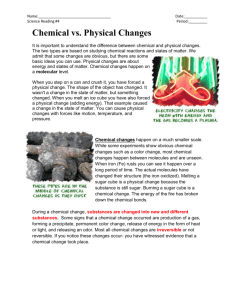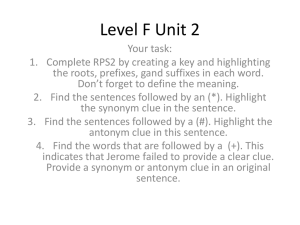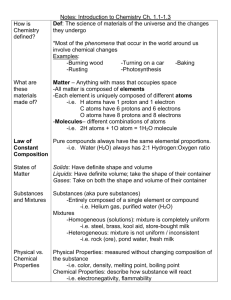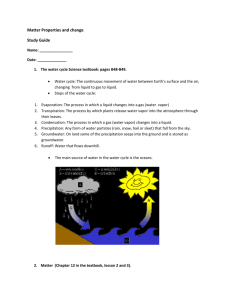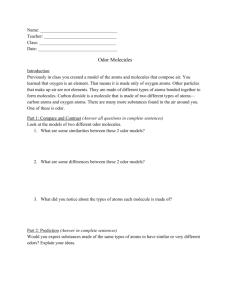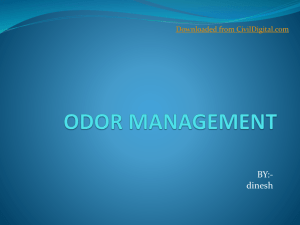Chemical Change vs. Physical Changes
advertisement
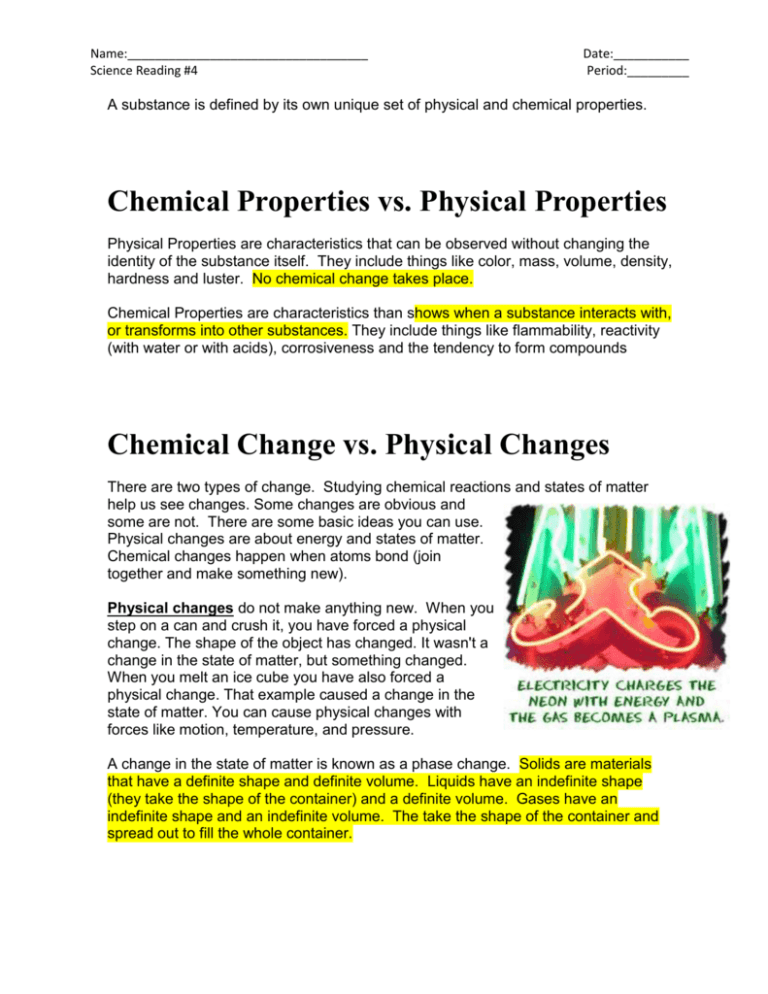
Name:___________________________________ Science Reading #4 Date:___________ Period:_________ A substance is defined by its own unique set of physical and chemical properties. Chemical Properties vs. Physical Properties Physical Properties are characteristics that can be observed without changing the identity of the substance itself. They include things like color, mass, volume, density, hardness and luster. No chemical change takes place. Chemical Properties are characteristics than shows when a substance interacts with, or transforms into other substances. They include things like flammability, reactivity (with water or with acids), corrosiveness and the tendency to form compounds Chemical Change vs. Physical Changes There are two types of change. Studying chemical reactions and states of matter help us see changes. Some changes are obvious and some are not. There are some basic ideas you can use. Physical changes are about energy and states of matter. Chemical changes happen when atoms bond (join together and make something new). Physical changes do not make anything new. When you step on a can and crush it, you have forced a physical change. The shape of the object has changed. It wasn't a change in the state of matter, but something changed. When you melt an ice cube you have also forced a physical change. That example caused a change in the state of matter. You can cause physical changes with forces like motion, temperature, and pressure. A change in the state of matter is known as a phase change. Solids are materials that have a definite shape and definite volume. Liquids have an indefinite shape (they take the shape of the container) and a definite volume. Gases have an indefinite shape and an indefinite volume. The take the shape of the container and spread out to fill the whole container. Name:___________________________________ Science Reading #4 Date:___________ Period:_________ Chemical change always creates something new. Some experiments show obvious chemical changes such as a color change. Most chemical changes happen between atoms and molecules and are unseen. When iron (Fe) rusts you can see it happen over a long period of time. The iron (Fe) atoms join with oxygen (O) atoms and form rust (FeO). The actual molecules have changed (the iron oxidized we call that rusting). Melting a sugar cube is a physical change because the substance is still sugar. Burning a sugar (C6H12O6) is a chemical change. Water (H2O) vapor is released and carbon (C6) is formed. During a chemical change, substances are changed into new and different substances. Some signs that a chemical change occurred are production of a gas, forming a precipitate, permanent color change, release of energy in the form of heat or light, and releasing an odor. Most all chemical changes are irreversible or not reversible. If you notice these changes occur- you have witnessed evidence that a chemical change took place. Name:___________________________________ Science Reading #4 Date:___________ Period:_________ Color Changes As in the case of autumn leaves, a change in color is a clue to indicate a chemical change. Perhaps you have found a half eaten apple that turns brown. The reason is that a chemical change has occurs when food spoils. You have just witnessed a spectacular chemical change if you have seen the leaves change color in the autumn. Energy – Released or Absorbed Energy can also be released during a chemical change. Fireworks release energy in a form of light that you can see. Fire gives off heat that you can feel. Name:___________________________________ Science Reading #4 Date:___________ Period:_________ Another sign of a chemical change is the release or gain of energy by an object. Many substances absorb energy to undergo a chemical change. Energy is absorbed during chemical changes involved in cooking, like baking a cake. When you bake a cake, energy is absorbed by the batter as it changes form a runny mix into a cake. Odor Changes It only takes one experience with a rotten egg to learn that they smell different than fresh eggs. When eggs and food spoil, they undergo a chemical change. The change in odor is a clue to the chemical change. When you smell an odd odor in foods such as chicken, pork or mayonnaise, you know that the food has undergone a chemical change. You can use this clue to avoid eating spoiled food and becoming ill. Name:___________________________________ Science Reading #4 Date:___________ Period:_________ Production of Gases or Solids As wood burns, it turns into a pile of ashes and gases that rise into air. After the wood is burned, it cannot be restored to its original form as a log. The formation of a gas is a clue to chemical changes. The bubbles of gas that you observed form when an antacid is dropped into water is an example of change. Another clue that a chemical change has occurred is the formation of a solid. A solid that separates out of solution during a chemical change is called a precipitate.
